Playtime! Here are eight mystery messiahs in an early stage of development, between infancy and late teens. All of these individuals became famous, or infamous, with images or names that are familiar to most people in literate Western society. Some of them are generally reviled, some of them admired; some of them are both, depending on whom you ask. As of the time of writing, only one of them is still alive. All of them will be examined in some detail in this series. How many of these messiahs-in-embryo look the part?
The adorable baby in #1 is Adolf Hitler, who became, with his bizarre little moustache and floppy forelock, one of the most recognizable faces of the 20th century, right up there with Elvis and Marilyn. There are commentators on Hitler who angrily denounce any publication of his baby picture as a literal “obscenity”, on the grounds that it humanizes him – whereas they wish him to be seen as a creature effectively outside humanity, whose acts can only be seen as historically unique and uniquely evil.
 There are those who would also see Hitler’s followers, the German volk in general, as fundamentally flawed, intrinsically different from the rest of humanity, and thus uniquely liable to commit the kind of evil that Hitler spearheaded. This is both demonstrably wrong and not terribly helpful in understanding what happened. Hitler was all too human, of a certain type; his rise and fall followed a common messianic pattern; the atrocities of the Nazi period, though horrific, were by no means unique; and Hitler’s worshippers were, in the main, perfectly normal humans reacting to a messiah in a perfectly normal way. His movement began on the dark side of politics in an era of despair, offering an illusion of light at the end of the post-Versailles tunnel. All of this is actually much scarier than seeing the Nazi phenomenon as unhuman or abnormal.
There are those who would also see Hitler’s followers, the German volk in general, as fundamentally flawed, intrinsically different from the rest of humanity, and thus uniquely liable to commit the kind of evil that Hitler spearheaded. This is both demonstrably wrong and not terribly helpful in understanding what happened. Hitler was all too human, of a certain type; his rise and fall followed a common messianic pattern; the atrocities of the Nazi period, though horrific, were by no means unique; and Hitler’s worshippers were, in the main, perfectly normal humans reacting to a messiah in a perfectly normal way. His movement began on the dark side of politics in an era of despair, offering an illusion of light at the end of the post-Versailles tunnel. All of this is actually much scarier than seeing the Nazi phenomenon as unhuman or abnormal.
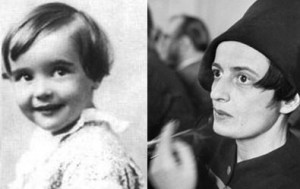 Messiah #2 is Ayn Rand, Russian-born American novelist and pop philosopher, author of the cult novels The Fountainhead and Atlas Shrugged, herself the fountainhead of the Objectivist movement and a major influence on the Libertarians and some frighteningly influential economists. How does she fit in here? Because the Objectivist movement, built around a philosophy of rationality and individualism, oddly enough displays all the characteristics of a messianic cult, including an interest in apocalypse and salvation. Rand displayed all the characteristics of a megalomaniac messiah, her novels standing in as Holy Writ. Her following started as a fan club of young intellectuals, with strong elitist overtones.
Messiah #2 is Ayn Rand, Russian-born American novelist and pop philosopher, author of the cult novels The Fountainhead and Atlas Shrugged, herself the fountainhead of the Objectivist movement and a major influence on the Libertarians and some frighteningly influential economists. How does she fit in here? Because the Objectivist movement, built around a philosophy of rationality and individualism, oddly enough displays all the characteristics of a messianic cult, including an interest in apocalypse and salvation. Rand displayed all the characteristics of a megalomaniac messiah, her novels standing in as Holy Writ. Her following started as a fan club of young intellectuals, with strong elitist overtones.
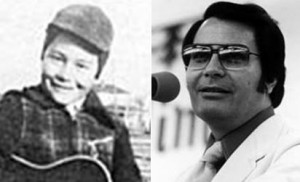 Number 3 is a heartbreaker, considering what this appealing little boy turned into: Jim Jones, the founder and pastor of The People’s Temple in California and of Jonestown in Guyana – notorious for leading over nine hundred of his followers to die with him on one apocalyptic day in 1978. Since that mass drinking of the Kool-Aid, Jones has become an archetype of the “nutty cult leader” – which makes him a reasonable benchmark for examining some of the other messiahs, and not just those whose stories ended in suicide. His technique was classic bait-and-switch; he used religion to get the punters in the door, then switched to his own formulation of Jonescentric Marxism.
Number 3 is a heartbreaker, considering what this appealing little boy turned into: Jim Jones, the founder and pastor of The People’s Temple in California and of Jonestown in Guyana – notorious for leading over nine hundred of his followers to die with him on one apocalyptic day in 1978. Since that mass drinking of the Kool-Aid, Jones has become an archetype of the “nutty cult leader” – which makes him a reasonable benchmark for examining some of the other messiahs, and not just those whose stories ended in suicide. His technique was classic bait-and-switch; he used religion to get the punters in the door, then switched to his own formulation of Jonescentric Marxism.
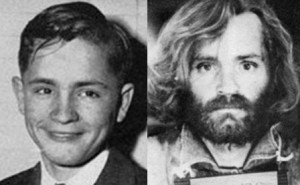 Number 4 is another heartbreaker. The good-looking teenager with the shy smile and ill-fitting suit is Charles Manson in 1949, aged fourteen. Like the aforementioned Roche Theriault, Manson was a messiah on a pathetically petty scale, controlling a harem of young women and a handful of young men. Unlike Theriault, Manson became notorious enough to be considered another twentieth-century archetype: the murderous mind-controlling Svengali-ish cult-leader. Most people know the outline of the story: how, in the summer of 1969, Manson sent his minions out to commit bloody massacre and thereby spark off the apocalypse, their victims including the beautiful and very pregnant actress Sharon Tate. And most of us also remember the continuing worship and bizarre behavior of his followers during his trial. Like Jim Jones, he provides a benchmark for looking at other messianic cults—and not just those that end in homicide. He approached his messiahship through rock music and the dark side of the ‘60s counterculture.
Number 4 is another heartbreaker. The good-looking teenager with the shy smile and ill-fitting suit is Charles Manson in 1949, aged fourteen. Like the aforementioned Roche Theriault, Manson was a messiah on a pathetically petty scale, controlling a harem of young women and a handful of young men. Unlike Theriault, Manson became notorious enough to be considered another twentieth-century archetype: the murderous mind-controlling Svengali-ish cult-leader. Most people know the outline of the story: how, in the summer of 1969, Manson sent his minions out to commit bloody massacre and thereby spark off the apocalypse, their victims including the beautiful and very pregnant actress Sharon Tate. And most of us also remember the continuing worship and bizarre behavior of his followers during his trial. Like Jim Jones, he provides a benchmark for looking at other messianic cults—and not just those that end in homicide. He approached his messiahship through rock music and the dark side of the ‘60s counterculture.
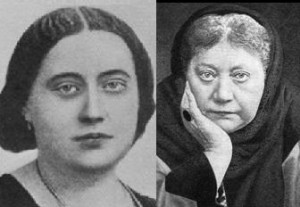 Next comes Madame Helena Blavatsky: conwoman, adventuress, spinner of an occult web that would mesh Eastern mysticism with Blavatsky’s own agenda to produce the theosophical movement and its spinoffs. Highly intelligent and utterly unscrupulous, she was part of—and a great beneficiary of—the nineteenth-century craze for spiritualistic and otherworldly things, and is one of those ultimately responsible for the enduring interest in Atlantis and mythical lost civilizations in current popular culture and pseudoarchaeology. That is to say, this bitch has a lot to answer for.
Next comes Madame Helena Blavatsky: conwoman, adventuress, spinner of an occult web that would mesh Eastern mysticism with Blavatsky’s own agenda to produce the theosophical movement and its spinoffs. Highly intelligent and utterly unscrupulous, she was part of—and a great beneficiary of—the nineteenth-century craze for spiritualistic and otherworldly things, and is one of those ultimately responsible for the enduring interest in Atlantis and mythical lost civilizations in current popular culture and pseudoarchaeology. That is to say, this bitch has a lot to answer for.
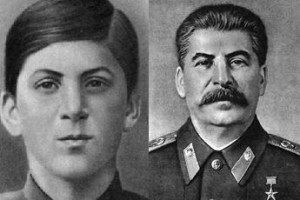 Number six is Josef Stalin, the man of steel, who finessed himself into a position as Lenin’s successor in controlling the Soviet empire. His modern reputation in the West is that of a rough and thuggish Georgian peasant. On the contrary, he was extremely intelligent and seminary-educated, and even a talented poet in his early years. His was a different role from that of, say, Hitler, but one that is no less important in the game of prophets and messiahs: he played the sidekick who inherits the reins of cultic power when the messiah falls or dies. The psychology that Stalin fostered in his brutal regime, however, was completely characteristic of a cultish mindset, and particularly of the so-called “cult of personality” – and though he is correctly recognized as a monster, responsible for many more miserable deaths than even Hitler, there are many in the modern Soviet Union who look back on him with admiration and nostalgia.
Number six is Josef Stalin, the man of steel, who finessed himself into a position as Lenin’s successor in controlling the Soviet empire. His modern reputation in the West is that of a rough and thuggish Georgian peasant. On the contrary, he was extremely intelligent and seminary-educated, and even a talented poet in his early years. His was a different role from that of, say, Hitler, but one that is no less important in the game of prophets and messiahs: he played the sidekick who inherits the reins of cultic power when the messiah falls or dies. The psychology that Stalin fostered in his brutal regime, however, was completely characteristic of a cultish mindset, and particularly of the so-called “cult of personality” – and though he is correctly recognized as a monster, responsible for many more miserable deaths than even Hitler, there are many in the modern Soviet Union who look back on him with admiration and nostalgia.
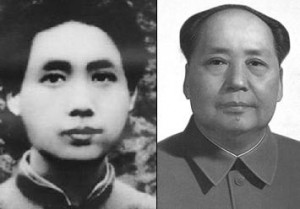 There should be no problem in recognizing this face: Mao Zedong, messiah of Red China, hero of the revolution, still worshipped by some in China as the next thing to a god. His was another cult of personality. He forms, with Hitler and Stalin, the great triumvirate of bloody-handed leaders of the twentieth century, with Pol Pot riding in on their coattails as Monster Number Four. Like Hitler’s regime, Mao’s rule became a nutty religious cult write very, very large. Unlike Hitler, Mao succeeded in dying while still in power, thus ending up as a mummified religious icon in Beijing, instead of a few charred bones in a box in Moscow. Structurally there are great similarities between Mao’s cult and Hitler’s – the chief difference is that Mao did not fail, and Hitler did. And yet, the sheer scale of Mao’s estimated body count far exceeds that of Adolf Hitler, and seriously competes with or even trumps Stalin’s. In a later entry, we will take a good long look at these so-called secular regimes, and see how they were in fact more religious than political in nature. His rise to messiah-hood depended on his genius for getting Moscow to back him, and his extraordinary survival skills.
There should be no problem in recognizing this face: Mao Zedong, messiah of Red China, hero of the revolution, still worshipped by some in China as the next thing to a god. His was another cult of personality. He forms, with Hitler and Stalin, the great triumvirate of bloody-handed leaders of the twentieth century, with Pol Pot riding in on their coattails as Monster Number Four. Like Hitler’s regime, Mao’s rule became a nutty religious cult write very, very large. Unlike Hitler, Mao succeeded in dying while still in power, thus ending up as a mummified religious icon in Beijing, instead of a few charred bones in a box in Moscow. Structurally there are great similarities between Mao’s cult and Hitler’s – the chief difference is that Mao did not fail, and Hitler did. And yet, the sheer scale of Mao’s estimated body count far exceeds that of Adolf Hitler, and seriously competes with or even trumps Stalin’s. In a later entry, we will take a good long look at these so-called secular regimes, and see how they were in fact more religious than political in nature. His rise to messiah-hood depended on his genius for getting Moscow to back him, and his extraordinary survival skills.
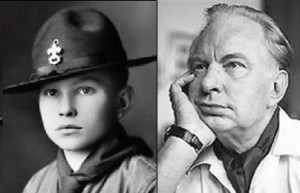 The last is L. Ron Hubbard, pulp science-fiction writer, self-proclaimed genius, and the inventor and messiah of Scientology. Like Ayn Rand’s Objectivism, formulated at about the same time, Hubbard’s Scientology claimed to be based on scientific and philosophical principles, and to provide an escape from religious superstition into a higher truth that was also good for you psychologically, like mental Weetabix. In fact, there are strong parallels between Rand’s movement and Hubbard’s; and like Rand, Hubbard slid into being a classic mind-control messiah. His cult is a fine demonstration of a principle that we shall explore in a later instalment: that where Holy Writ is concerned, what makes perfect sense to insiders may sound perfectly batty to outsiders. His first approach to messianic status was not through religion or politics, but through pseudoscience; the pseudoreligious trappings came later.
The last is L. Ron Hubbard, pulp science-fiction writer, self-proclaimed genius, and the inventor and messiah of Scientology. Like Ayn Rand’s Objectivism, formulated at about the same time, Hubbard’s Scientology claimed to be based on scientific and philosophical principles, and to provide an escape from religious superstition into a higher truth that was also good for you psychologically, like mental Weetabix. In fact, there are strong parallels between Rand’s movement and Hubbard’s; and like Rand, Hubbard slid into being a classic mind-control messiah. His cult is a fine demonstration of a principle that we shall explore in a later instalment: that where Holy Writ is concerned, what makes perfect sense to insiders may sound perfectly batty to outsiders. His first approach to messianic status was not through religion or politics, but through pseudoscience; the pseudoreligious trappings came later.
This small sample covers a fair range of phenomena which are not normally considered to be closely related, with each tracing a different trajectory towards infamy or fame. There are three national leaders, each the subject of a personality cult, and each with a monstrous reputation: Hitler, Stalin, Mao. There are four founders of their very own religious or philosophical movements: Rand, Blavatsky, Hubbard, Jones. And there is a convicted mass murderer, Charles Manson, guru of the cult commune known as “the Family”. Put them together, and you have both a hall of fame and a rogue’s gallery.
Whatever the judgment of history and ourselves, each of these personages was (and/or still is) an object of adulation. Sane, ordinary people willingly handed over to them their lives and hopes, even – in several cases – to the point of being prepared to kill or die for them. Clearly, not all leaders are cut from messianic cloth; clearly, some do justify their followers’ faith. But how can we distinguish between good guys and bad guys? And what, good or bad, do they have in common? One clue is how often a certain four-letter word pops up when charismatic leaders are discussed. That word is cult, and it will be the basis for the next instalment of this series.

